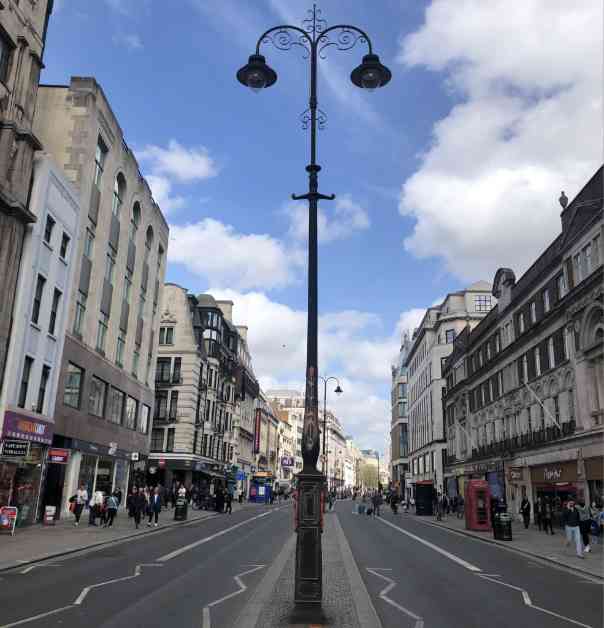**Exploring the Strand: A Comprehensive Guide to London’s Iconic Street**
As you step off at Embankment station and onto the pavement beside the Golden Jubilee Bridge, you are transported back in time, imagining the Thames as it was 2,000 years ago when it was wider, lapping at your feet. Turning left into Victoria Embankment Gardens, a green oasis created in 1874 by Sir Joseph Bazalegette after building the Embankment itself, you are greeted by vibrant tulips in the spring. Walking through the gardens and heading east on Watergate Walk, you pass by the al fresco tables of Gordon’s Wine Bar, proudly claiming to be London’s oldest wine bar. Continuing on, you traverse George Court, passing by the LGBTQ+ Retro Bar, before ascending steps and emerging onto one of London’s most famous streets – the Strand.
**History of the Strand: From Roman Routes to Modern Marvels**
Originally forming part of the Roman route between Londinium and Silchester, the Strand’s name is derived from the Old English word “strond”, meaning beach or shore. Records dating back to the year 1002 mention a “strondway”, a path along the Thames where Vikings and Anglo-Saxons once vied for control. Over the centuries, the street has undergone various name changes, reflecting its rich history and diverse influences. In the 13th century, a section of the Strand was known as “Densemanestret” due to its Danish population.
Standing on the central pedestrian refuge strip, you can admire the ornate lampposts and reflect on the Strand’s role as a vital link between the City and Westminster, the financial and political cores of London. Serving as the southern boundary of Covent Garden, the Strand has long been a hub of entertainment and culture. As you stroll along, you encounter iconic landmarks that have shaped the street’s identity and character over the centuries.
**Landmarks and Legends: The Adelphi Theatre, Vaudeville, and More**
At 409-412 Strand stands the art deco Adelphi Theatre, which was acquired by Andrew Lloyd Webber’s company in 1993. The site has a rich theatrical history, with three playhouses previously occupying the space. The Adelphi Theatre first opened as Sans Pareil in 1806, later adopting its current name in honor of the nearby Adelphi Buildings. Developed by the Adam siblings from Scotland, the Adelphi Buildings were grand terraced houses that were eventually replaced by the Adelphi office building in the 1930s.
Adjacent to the Adelphi Theatre is the Vaudeville, a historic theater dating back to 1870. Just down the street at 399 Strand, Stanley Gibbons has been the headquarters of the renowned postage stamp collecting company for over a century. Across from these establishments stands Eighty Strand, also known as Shell Mex House, a prominent office building that housed an oil business until the 1990s. Its iconic clock, known as “Ben Benzene,” overlooks the Thames and serves as a distinctive landmark on the Strand.
**The Savoy Hotel and The Lyceum: Icons of Luxury and Entertainment**
The Savoy Hotel, synonymous with luxury and opulence, was originally an extension of the Savoy Theatre, which opened in 1881 under the direction of impresario Richard D’Oyly Carte. The theater was the first public building in the world to be lit entirely by electricity, a pioneering feat in Victorian London. The hotel, designed by Thomas Edward Collcutt, welcomed its first guests in 1889 and has since hosted a myriad of distinguished guests from the arts and entertainment world, including Claude Monet, Judy Garland, and Bob Dylan.
Nearby, the Lyceum Theatre, with its origins dating back to the 1760s, has undergone several renovations and transformations over the years, culminating in its revival as a rock music venue in the late 20th century. As you traverse the Strand, you encounter a rich tapestry of history and culture, with each landmark offering a glimpse into London’s storied past.
**Aldwych and Beyond: A Glimpse into London’s Historic Heart**
Continuing eastward, you arrive at Aldwych, meaning “old port,” a significant area in Anglo-Saxon Lundenwic. The pedestrianization of the Strand has revitalized this historic thoroughfare, with notable landmarks such as Bush House, once home to the BBC World Service and now part of King’s College Strand campus, and Somerset House, a cultural complex housing the Courtauld art gallery and other treasures.
Along the Strand’s south side, English baroque churches such as St. Clement Danes and St. Mary le Strand have been preserved, offering a glimpse into London’s architectural heritage. St. Clement Danes, possibly founded by Danes in the 9th century, boasts a stunning interior designed by Christopher Wren, while St. Mary le Strand, controversial in its time, is now revered for its lavish architecture.
As you reach the eastern end of the Strand, you encounter the Royal Courts of Justice, marking the border between Westminster and the City of London. The Strand seamlessly transitions into Fleet Street, another historic thoroughfare that has played a pivotal role in London’s development.
**Exploring the Strand: A Journey Through Time and Tradition**
The Strand’s rich history and diverse cultural heritage make it a must-visit destination for anyone exploring London’s iconic streets. From its Roman origins to its modern-day landmarks, the Strand offers a unique blend of past and present, reflecting the city’s ever-evolving landscape.
As you wander along this historic street, take a moment to appreciate the architectural wonders, cultural institutions, and vibrant atmosphere that define the Strand. Whether you’re a history buff, a theater enthusiast, or simply a curious traveler, the Strand has something to offer everyone.
So, lace up your walking shoes, grab a map, and embark on a journey through time and tradition along the Strand – London’s iconic street that continues to captivate and inspire visitors from around the world.





















